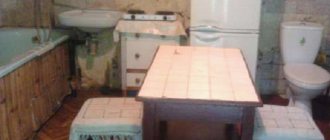An apartment in an apartment building cannot have an open layout. If when buying an apartment you heard the phrase “apartment with an open plan”, then check with the seller whether you can swap the kitchen and toilet? Most likely the seller will hesitate and say “no”. By “free layout” they mean that there are no walls in the apartment and you can make it the layout you want, but with great restrictions!
Look at the documents you have for the apartment. There will definitely be a plan. If you already have a BTI plan, then it is somewhat easier for you, since the apartment is already divided into zones. The apartment below you usually has the same floor plan as your apartment. Your layout is limited by the following rules and regulations:
SanPiN 2.1.2.2645-10
1) 3.8. In apartments it is not allowed: - the location of bathrooms and toilets directly above living rooms and kitchens, with the exception of two-level apartments, in which it is allowed to place a toilet and a bath (or shower) directly above the kitchen; - fastening of devices and pipelines of sanitary units directly to the enclosing structures of the living room, inter-apartment walls and partitions, as well as to their extensions outside the living rooms. If your neighbor has a living room below you, then you cannot organize a toilet or kitchen in your own place. 2) 4.7. Natural ventilation of residential premises should be carried out by air flow through vents, transoms, or through special openings in window sashes and ventilation ducts. Duct exhaust openings should be provided in kitchens, bathrooms, toilets and drying cabinets. The design of the ventilation system must prevent the flow of air from one apartment to another. It is not allowed to combine the ventilation ducts of kitchens and sanitary facilities with living rooms. Ventilation ducts must be separate. 3) 5.1. Living rooms and kitchens of residential buildings must have natural lighting through light openings in the external building envelope. You cannot make a living room or kitchen without a window. 4) 3.9. It is not allowed to arrange an entrance to a room equipped with a toilet directly from the kitchen and living rooms, with the exception of the entrance from the bedroom to the combined bathroom, provided that there is a second room in the apartment, equipped with a toilet, with an entrance to it from the corridor or hall. If you have one toilet, then the only exit is into the corridor.
Is the neighbor a controlling “authority”?
Exactly. The housing inspectorate, the management company and even other residents have the right to initiate proceedings regarding illegal redevelopment. A statement from a vigilant neighbor to the BTI, or even the prosecutor's office, is enough for a competent inspection to come.
On a note. Based on the information received, regulatory authorities have the right to carry out an unscheduled inspection to identify and suppress violations of housing legislation. Based on the identified facts, administrative proceedings are initiated with the possible transfer of materials to the court.
It is better not to bring the situation into conflict with the law by agreeing on the upcoming work in advance.
You can learn how to properly legalize redevelopment in an apartment by watching the video:
See also Phone numbers for consultation Jan 07, 2021 kasjanenko 1160
Share this post
Discussion: 4 comments
- Ivan says:
06/08/2019 at 13:39Many transfers and redevelopments can cause security threats to other residents of this house. Are there any rules regarding criminal punishment for officials who gave permission for the reconstruction of an apartment, which then caused damage to the entire house?
Answer
- Nikolay says:
07/31/2019 at 08:23
I don’t understand, if the kitchen is gasified, then you can’t demolish the partition, but sliding panels can. What good are these sliding doors if there is a gas leak? Can they compare with a solid solid wall, of course not.
Answer
- Oleg says:
01/16/2020 at 16:09
How should a tenant act if he suspects that one of the apartments in his building is undergoing renovation work with the demolition of major partitions? Do the owners of such an apartment have a right not to let a local police officer inside if he doesn’t have a warrant?
Answer
- Anna says:
08/18/2020 at 12:13
At one time, almost half of our house, without any legalization, moved the kitchens to the loggias, breaking out the walls between the kitchen and the loggia, and then somehow some legalized it, and some still didn’t, but it seems to me that such alterations are generally prohibited . We wrote so many applications to replace the gas pipe. and here is such a change, moving the gas stove to the loggia. Why allow this at all? This is the safety of a huge house, and then houses explode from such remodelers.
Answer
SNiP 2.03.13-88 “Floors”
7) Prohibited: Installation of floors in bathrooms and other wet rooms without waterproofing. Please note that a construction organization performing waterproofing work must be included in the SRO register . Additionally, it is better to photograph the process of creating waterproofing. Prohibited: Installing a floor in a bathroom without a threshold or without lowering it by 15-20 mm. regarding the adjacent room (clause 4.11 of the “Technical requirements and rules for design, installation, acceptance, operation and repair”) The implementation of the threshold can be different, the main thing is that the water does not leave the bathroom. You can also make a smooth transition.
Additionally, it is better to photograph the process of creating waterproofing. Prohibited: Installing a floor in a bathroom without a threshold or without lowering it by 15-20 mm. regarding the adjacent room (clause 4.11 of the “Technical requirements and rules for design, installation, acceptance, operation and repair”) The implementation of the threshold can be different, the main thing is that the water does not leave the bathroom. You can also make a smooth transition.
How to legalize redevelopment in an apartment?
To obtain official permission to move the kitchen to another room, you must first obtain a registration certificate for the apartment (you can use the old one if it is no more than 5 years old). You can order it at the BTI or the Multifunctional Center. Having received the technical passport in hand, the owner goes to the design organization and orders a redevelopment project there.
After this, a package of documents is prepared for submission to the Housing Commission, it includes:
- statement;
- redevelopment project;
- registration certificate;
- title documents;
- consent of all apartment residents to carry out the planned actions.
After 45 days, the applicant receives a response. If it is negative, the apartment owner will have to refuse to implement his idea or try to appeal the verdict in court. If the commission's decision is positive, construction work can begin.
They must be completed before the expiration date of the permit document. Typically, redevelopment takes 1 year. Upon completion of the repairs, the owner again writes an application to the Housing Commission, notifying it of the completion of the work. It is necessary to attach to it a work log, which is kept by designers during designer supervision.
On the day of the site visit by members of the commission, the apartment owner is recommended to invite representatives of the design organization and construction team. In their presence it is easier to resolve controversial issues. Moreover, they are required to put their signatures on the redevelopment acceptance certificate. After this, the owner just has to get a new registration certificate for the apartment.
Dear readers! To solve your problem right now, get a free consultation
— contact the on-duty lawyer in the online chat on the right or call:
+7
— Moscow and region.
+7
— St. Petersburg and region.
8
- Other regions of the Russian Federation
You will not need to waste your time and nerves
- an experienced lawyer will take care of solving all your problems!
ST 40 Residential Complex of the Russian Federation
10) 1. The owner of a premises in an apartment building, when acquiring ownership of a premises adjacent to the premises in an apartment building owned by him, has the right to combine these premises into one premises in the manner established by Chapter 4 of this Code. The boundaries between adjacent premises may be changed or these premises may be divided into two or more premises without the consent of the owners of other premises if such a change or division does not entail a change in the boundaries of other premises, the boundaries and size of common property in an apartment building or a change shares in the right of common ownership of common property in this house. Apartments cannot be combined if they have different owners; they can only be combined if they have the same owner.
Other prohibitions:
11) Direct combination of the kitchen with the living room in the presence of a gas stove.
12) The organization of a kitchen niche with an area of less than 5 sq.m is prohibited.
13) Removing thresholds when exiting to a balcony in panel houses.
14) Dismantling of window sill blocks or making openings in load-bearing walls in standard houses built after 2007, the author of which is the MNIITEP design institute, which does not give its permission for this.
15) Expansion of openings in external walls when accessing a balcony (loggia) in panel and brick houses, since the authors of the house project do not give their consent to this;
16) Dismantling the window sill block in brick houses, if it holds the balcony slab due to pinching;
Options for rearranging space
The main problem of kitchen space in typical apartments is its small size and inconvenient location . To solve this problem, there are several options that do not contradict existing standards.
Read our articles about how to coordinate the redevelopment of a balcony, loggia or bathroom.
Expansion with a cabinet or storage room
This option is ideal if there is a pantry or built-in closet . The partitions between these rooms are most often non-load-bearing, so dismantling them does not cause problems and combining them with a storage room is possible.
Kitchen in the hallway or room
Redevelopment of housing: moving the kitchen into the living room - is it possible? How to legalize the transfer process?
This is only possible if you live on the ground floor , since there are non-residential premises below you. Such redevelopment above the living room is prohibited.
In addition, transfer is allowed if the kitchen equipment is located above or below the non-residential area of neighboring apartments (corridor, hallway, pantry, built-in closet).
Is it possible to move it to the corridor? If you wanted to move it to the corridor, then there should be a window . It is not allowed to place it in rooms with various types of lighting without natural light.
Alternatively, instead of completely moving it into the hallway, you can use the technique of expanding the size of the kitchen at the expense of the corridor . Part of the equipment is transferred into it and due to this, part of the space is freed up.
You just have to take into account that the partition can only be demolished if it is not a load-bearing wall .
When transferring, you must take into account the need to transfer ventilation, gas and water pipes, and sewerage.
The ventilation duct must be connected to the former kitchen ventilation. Moving it to the bathroom ventilation is prohibited.
Particular attention should be paid to the gas supply. Moving gas pipes can only be done with the permission of the Gas Service , otherwise this organization may prohibit your changes.
If you decide to place a room on the site of a former kitchen, the kitchen of your neighbors should not be located under it, otherwise the commission will not allow .
Although in order to coordinate the transfer of a room in this case, it is necessary to designate this room as an office in the project. Having received approval, you can subsequently equip it with any furniture at your discretion.
Merging with another room
Is such a combination possible in a house - combining a kitchen and a room? Demolition of the wall and consolidation is one of the popular solutions nowadays.
It has become quite fashionable to combine it with the living room. And this option is quite acceptable if the home is equipped with an electric stove .
The exception is when the partition is a load-bearing wall .
By law, the dismantling of load-bearing walls, as well as the installation of arches and niches in them, is prohibited. The only option is to install an opening in such a wall, provided that it is reinforced with metal structures .
If the housing is equipped with gas, it will also be possible to combine the space, but provided that a movable partition or blinds .
In new houses, you can replace the gas stove with an electric one , then unification will become possible. In old houses, this option is not possible due to the fact that the electrical wiring will not withstand the increased load. In addition, electricity tariffs in such houses will not be discounted, so electricity costs will immediately increase.
You can combine a kitchen with a living space if the apartment has two or more rooms. In a one-room apartment, this option is impossible, since the room will become non-residential, and there cannot be an apartment without residential areas.
This ban can be circumvented by installing a partial or movable partition that zones the space.
Attaching a balcony
Standard apartments often have access from the kitchen to a balcony or loggia, and the option of combining them is very successful if you want to change something . This makes it possible to expand the space by moving furniture or other items to the balcony, as well as make the kitchen space brighter.
An ordinary balcony or loggia will become a bay window or panoramic window, which will add some zest to the whole room. You can organize a dining area on the loggia, which will significantly increase your work space .
The only downside is some restrictions :
- impossibility of dismantling the window sill block or partitions of load-bearing walls;
- moving heating radiators to the balcony;
- installation of heated floors on the balcony with connection to general house communications.
A window sill block that cannot be demolished can be turned into a bar counter or a kind of dining table. This technique will add originality to this area and the entire housing in general.
Complete transfer of equipment to the loggia , and the loggia becomes a working area. In this case, the space in the same place will only be in the dining area, in which you can also equip a seating area.
It is impossible to move the equipment to the remote balcony, due to the increased load on its floors.
Expansion due to the bathroom
Expanding the kitchen at the expense of the bathroom - this option for remodeling the space is possible if part of this room is located above the neighbors’ bathroom . You cannot place your bathroom above your neighbor’s kitchen. It is also impossible if your kitchen is located under the neighbor’s bathroom.
When expanding due to the bathroom, it is possible by moving one of them to another. The bathroom will become smaller and combined , and the kitchen will be slightly larger. Of course, its size will not become much larger, but in small-sized housing, even such a slight increase can be useful.
The process of legalizing an expansion at the expense of a bathroom is one of the most difficult; it is not always possible to obtain permission for such a change from specialists. A 100% option for such a conversion is only to locate the housing on the top floor.
Read on our website about where to start remodeling an apartment, where to order a project and obtain permission for redevelopment.
SP 54.13330.2011
17) In the apartments specified in 5.3, the area must be no less than: common living room in a one-room apartment - 14 m2, common living room in apartments with two or more rooms - 16 m2 , bedrooms - 8 m2 (10 m2 - in two Human); kitchens - 8 m; kitchen area in the kitchen - dining room - 6 m2. In one-room apartments it is allowed to design kitchens or kitchen niches with an area of at least 5 m2.
There are some exceptions to this. If your living room is not up to standard, please contact us by phone and we may be able to help you.
Kitchen and bathroom design
If you have installed partitions and the kitchen is visually smaller, you can compensate for this with light walls and pastel shades of kitchen furniture. Additionally, hang mirror elements on the walls and ceiling that will expand the space.
Folding tables and chairs will help you save extra meters, which every housewife needs when cooking. Instead of a separate table, you can put a bar counter and bar stools. In the bathroom, you can save space by removing the sink and floor cabinets.
A bathtub in the kitchen in an old building is not a death sentence. You can change its location, replace it with a shower stall or separate it with a partition. Why there is a bathtub in the kitchen and who came up with it is a big question, but today you don’t have to put up with this design, you can change it.









